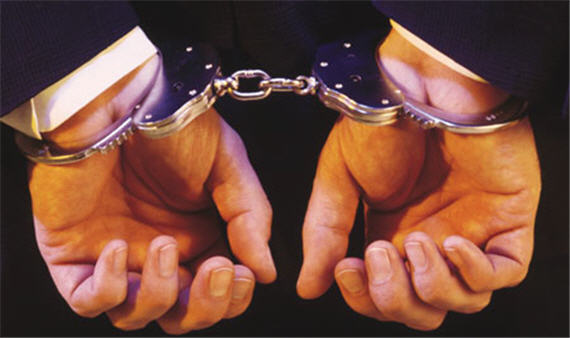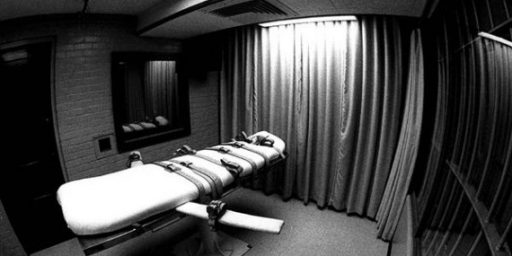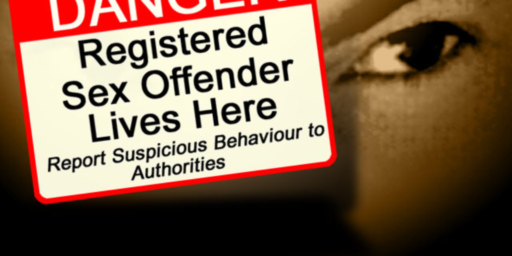Study: At Least 2,000 People Wrongfully Convicted In 23 Years
Innocent people have gone to jail, and some of them are still sitting there.
A new study has unveiled at least 2,000 incidents over the past 23 years in which people were convicted of a crime that they didn’t commit:
More than 2,000 people who were falsely convicted of serious crimes have been exonerated in the United States in the past 23 years, according to a new archive compiled at two universities.
There is no official record-keeping system for exonerations of convicted criminals in the country, so academics set one up. The new national registry, or database, painstakingly assembled by the University of Michigan Law School and the Center on Wrongful Convictions at Northwestern University School of Law, is the most complete list of exonerations ever compiled.
The database compiled and analyzed by the researchers contains information on 873 exonerations for which they have the most detailed evidence. The researchers are aware of nearly 1,200 other exonerations, for which they have less data.
They found that those 873 exonerated defendants spent a combined total of more than 10,000 years in prison, an average of more than 11 years each. Nine out of 10 of them are men and half are African-American.
Nearly half of the 873 exonerations were homicide cases, including 101 death sentences. Over one-third of the cases were sexual assaults.
DNA evidence led to exoneration in nearly one-third of the 416 homicides and in nearly two-thirds of the 305 sexual assaults.
At first glance, you might say that 2,000 wrongful convictions over 23 years, but that only lasts as long as it takes you to realize that the data that the two universities based their study on was limited, and that some jurisdictions reported numbers that quite simply aren’t believable:
The overall registry/list begins at the start of 1989. It gives an unprecedented view of the scope of the problem of wrongful convictions in the United States and the figure of more than 2,000 exonerations “is a good start,” said Rob Warden, executive director of the Center on Wrongful Convictions.
“We know there are many more that we haven’t found,” added University of Michigan law professor Samuel Gross, the editor of the newly opened National Registry of Exonerations.
Counties such as San Bernardino in California and Bexar County in Texas are heavily populated, yet seemingly have no exonerations, a circumstance that the academics say cannot possibly be correct.
The registry excludes at least 1,170 additional defendants. Their convictions were thrown out starting in 1995 amid the periodic exposures of 13 major police scandals around the country. In all the cases, police officers fabricated crimes, usually by planting drugs or guns on innocent defendants.
Regarding the 1,170 additional defendants who were left out of the registry, “we have only sketchy information about most of these cases,” the report said. “Some of these group exonerations are well known; most are comparatively obscure. We began to notice them by accident, as a byproduct of searches for individual cases.”
Perhaps the most significant piece of information about this database, as limited as it may be, is that it makes quite c ear that wrongful convictions and the factors that lead to them aren’t limited to high-profile cases. When exoneration cases do get publicity, it’s usually in situations involving rape and murder, of course. Here at OTB, we’ve made note of three death penalty cases from the State of Texas alone — Cameron Todd Willingham, Claude Jones, and Carlos DeLuna — where men were executed for crimes they didn’t commit. In the State of Mississippi, Cory Maye spent ten years on death row for a capital murder conviction tainted by racism, improper testimony from a corrupt Medical Examiner, and a case of mistaken identity by police conducting a no-knock drug raid. Beyond those cases, we’ve all seen more than one story about a man, and it’s usually always a man and an African American man at that, who has spent decades in prison for a crime they didn’t commit. What this study makes clear, though, is that it isn’t just rape and murder that leads to improper convictions, and that the factors that bring it about are rather unsurprising:
In half of the 873 exonerations studied in detail, the most common factor leading to false convictions was perjured testimony or false accusations. Forty-three percent of the cases involved mistaken eyewitness identification, and 24 percent of the cases involved false or misleading forensic evidence.
In two out of three homicides, perjury or false accusation was the most common factor leading to false conviction. In four out of five sexual assaults, mistaken eyewitness identification was the leading cause of false conviction.
Seven percent of the exonerations were drug, white-collar and other nonviolent crimes, 5 percent were robberies and 5 percent were other types of violent crimes.
The problem of faulty eyewitness identification is one that has been well-known in the criminal justice field for years, even though most lay observers seem to think that, out side of DNA, it is one of the most reliable types of evidence presented at trial. The reality, as I noted, is far different, as the Supreme Court of New Jersey acknowledged when it completely revamped the Court rules for eyewitness testimony after an exhaustive study that showed just how unreliable it can be:
“Study after study revealed a troubling lack of reliability in eyewitness identifications,” Chief Justice Rabner wrote. “From social science research to the review of actual police lineups, from laboratory experiments to DNA exonerations, the record proves that the possibility of mistaken identification is real.
“Indeed, it is now widely known that eyewitness misidentification is the leading cause of wrongful convictions across the country.”
The decision listed more than a dozen factors that judges should consider in evaluating the reliability of a witness’s identification, including whether a weapon was visible during a crime of short duration, the amount of time the witness had to observe the event, how close the witness was to the suspect, whether the witness was under the influence of alcohol or drugs, whether the witness was identifying someone of a different race and the length of time that had elapsed between the crime and the identification.
Chief Justice Rabner said the court had avoided “bright-line rules that would lead to suppression of reliable evidence any time a law enforcement officer makes a mistake.”
The ruling instead allowed for a much more complete exploration of the factors involved in an identification “to preclude sufficiently unreliable identifications from being presented and to aid juries in weighing identification evidence.”
Chief Justice Rabner noted that in the vast majority of cases, identification evidence would still be presented to a jury.
“The threshold for suppression remains high,” he wrote. And because, in most cases, juries will continue to determine the reliability of eyewitness testimony, Chief Justice Rabner added, “it is essential to educate jurors about factors that can lead to misidentifications.”
Indeed, given the fact that this study found that nearly half of the wrongful convictions this study dealt with involved mistaken eyewitness identification, one would think that this reform that is long overdue throughout the country.
It would be interesting to see this study expanded to see just how big a problem wrongful convictions actually is, and perhaps to add into it some study of people who ended up confessing to crimes they didn’t commit. Given the fact that some jurisdictions don’t even keep data on this matter, though, that won’t be an easy task. Suffice it to say, though, that it seems rather self-evident that the number of wrongful convictions over the past two decades has been far more than 2,000. What this study does make clear, though, as limited as it is, is that we need to seriously look at the way we trial crimes in this country and ask ourselves whether its worth ruining the lives of so many people just to make it more “efficient.”






Just to emphasize, it’s been at least decades since the fallibility of eyewitness testimony has been known. Here is one paper from the seventies, for example.
Anon,
In the legal community and among those who pay attention to such issues, yes. In my conversations with lay people, however, I tend to find that many people still seem to think that eyewitness testimony is far more reliable than it actually is.
Part of the problem is that for police and prosecuters, there’s a lot of pressure to close as many cases as possible, but pretty much no penalty for falsely convicting someone, even in cases where it was intentional. It’s not suprising the incentives in place lead to a situation where people are more interested in finding the first person they can pin it on and railroading them then they are in doing a thorough investigation.
Thank you for continuing to cover this issue. Having seen the court system at work only a few times, on matters that certainly aren’t life-or-death, it is frightening to contemplate what must be occurring weekly in the courthouse just up the road in our little county.
I served jury duty only once in my two decades here, a DUI case. The defendant may well have been guilty, but the arresting officer with encouragement of the local prosecutor was obviously perjuring himself. His story was even less credible than the defendant’s, which itself was pretty unlikely.
I was so angered that I knew I would vote to acquit as soon as we received instructions, and two others and I hung the jury. I never learned the fate of the defendant upon retrial, if there was one. I marvelled that the judge did not cuff both the officer and the prosecutor for having wasted everyone’s time with a clearly perjured case.
What if this had been a rape or murder case? I came away frightened by the experience. It made me a most very reluctant advocate of the death penalty, reserved for only the most heinous and obvious cases. This state employs it very infrequently, for which I am grateful.
I knew a man who was falsely imprisoned for a robbery. H e was convicted by witness testimony only. He spent 8 months in jail but they caught the real criminal later. My friend was shocked at how much the man looked like him. The worst part is he still has to deal with the problem of being a convicted felon even though he did not do it. He never received any compensation for this either.
What they need to do is tell the jury at the very beginning about some of the issues with Eyewitness Testimony. Even a statement like “mistaken eyewitness testimony is the leading cause of wrongful convictions and is responsible for X number of wrongful convictions” might make the jury more skeptical about the eyewitness testimony that might used in the proceeding trial.
@Brett: That sounds prejudicial to me.
We can look back before the ’70s…See Rashomon (1950) The excellent film by
Dir. Akira Kurosawa.
Just more proof that we shouldn’t have the death penalty. Since the good Tsar didn’t feel like responding in the other thread, perhaps he will be so kind as to indulge us here. Specifically, the cost vs. benefit of death penalties vs. life imprisonment.
Well, there’s a difference between an exoneration and a wrongful conviction in the literal sense. Many exonerations are based upon after-the-fact DNA evidence that casts reasonable doubt upon the conviction. Doesn’t necessarily mean the guy was innocent, however.
Example: Man convicted in pre-DNA era of rape and murder based upon physical and other evidence, not including any eye witness accounts. Cigarette butt also found near the scene and collected. Not introduced at trial. Years later DNA evidence determines retroactively that someone else smoked that cigarette. Reasonable doubt. Man released.
That sort of thing actually happens. Man still probably was guilty. Just not in the legal sense.
How many exonerations actually involved people who were guilty as charged or at least guilty of being accomplices to the primary perpetrator? What percentage?
@Franklin: Offing a capital offender after a few years of legal appeals/writs costs society, i.e., taxpayers, a helluva lot less than keeping him in a cage for perhaps 50-60 years or more. It also eliminates any possibility of an early release via clemency. You have to ask yourself which is the greater prospective tragedy: An innocent man convicted of a capital crime being executed or a guilty man convicted of a capital crime being released via clemency or pardon and then killing again? Besides, which penalty is more cruel? Taking a 20 year-old kid and caging him like an animal for several decades or sticking a needle in his arm and ending it quick? I might argue that LWOP is the cruelest penalty of all. Many young convicts would agree.
Eye witness accounts definitely are a problem. There’s not a cut-and-dried solution. More comptetent and more dedicated criminal defense attorneys certainly would help.
Speaking of which, I could not help but notice that that study was authored by Northwestern Univ.’s School of Law and the Univ. of Michigan’s School of Law. Combined those two universities as of 2011 were sitting on $15 billion in endowment monies. That’s billion with a “b.” Perhaps they should take a tiny fraction of those sums and directly subsidize non-profit legal clinics and pro bono attorneys who specialize in criminal defense, appeals and writs. Wouldn’t that be more utilitarian than spending thousands of man hours trying to prove a political point? Don’t hold your breath, however. In the world of academia money talks louder than words.
What needs to be done here is to release these people immediately. Taking their place will be the criminals that the soft on judges have released time after time at their revolving door courts to crawl the streets like animals and prey on innocent, law abiding citizens. What also needs to be done is to put some of these judges in their with them for about an hour.